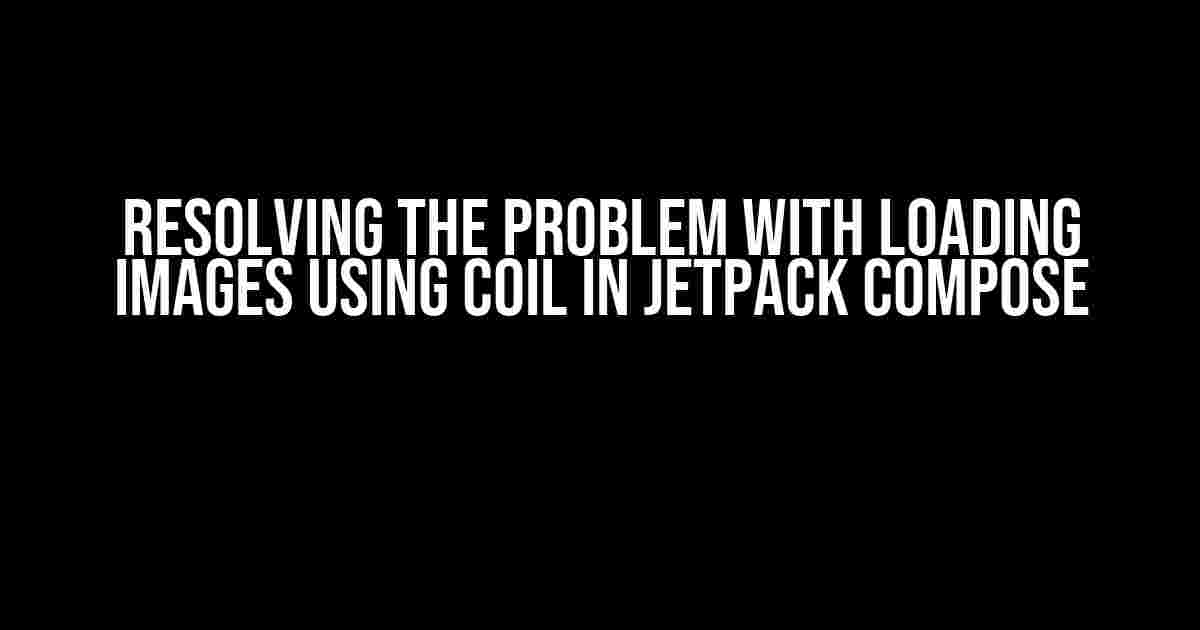When building Android apps with Jetpack Compose, loading images can be a challenging task, especially when using Coil, a popular image loading library. One common issue developers face is the problem of loading images using Coil, which can lead to frustrating errors and wasted development time. In this article, we’ll explore the common causes of this problem and provide solutions to get you back on track.
Cause 1: Incorrect Coil Dependency
The first potential cause of the problem is an incorrect Coil dependency in your build.gradle file. Make sure you’re using the correct version of Coil that’s compatible with your Jetpack Compose version.
- In your build.gradle file, check if you’re using the correct Coil dependency:
- Add the following line to your dependencies block:
implementation 'io.coil-kt:coil-compose:2.1.0'
Cause 2: Missing Coil Initialization
Another common cause of the problem is failing to initialize Coil in your app. Coil requires initialization before you can use it to load images.
- In your App’s EntryPoint (e.g., MainActivity), initialize Coil in the onCreate function:
- Add the following code:
Coil.initialize(this)
Cause 3: Incorrect Image Request
A poorly constructed image request can also cause issues when loading images using Coil.
- Verify that your image request is correctly formatted:
- Use the
coils.ImageRequestfunction to build your image request: - Example:
val request = ImageRequest.Builder(context).data(imageUrl).build()
Cause 4: Coil Configuration Issues
Coil’s configuration settings can also impact image loading. Ensure that your Coil configuration is correctly set up.
- Check your Coil configuration:
- Verify that you’ve set the correct imageDiskCache and memoryCache sizes:
- Example:
Coil.config { ... }
Conclusion
By addressing these common causes of the problem with loading images using Coil in Jetpack Compose, you should be able to resolve the issue and get back to building your app. Remember to double-check your Coil dependency, initialization, image request, and configuration settings to ensure smooth image loading in your app.
Frequently Asked Question
Got stuck while loading images using Coil in Jetpack Compose? Don’t worry, we’ve got you covered! Here are some commonly asked questions and their solutions:
I’m getting a blank screen while loading images using Coil. What’s going on?
This might be due to the Coil image loader not being initialized. Make sure to call `Coil.setImageLoader` before loading any images. Also, ensure that you’ve added the Coil dependency in your build.gradle file.
Why are my images not being cached using Coil?
Coil uses a disk cache by default, but it might not be enabled in your case. Try setting `diskCachePolicy` to `DiskCachePolicy.ENABLED` in your `ImageLoader` configuration. Also, ensure that you’ve added the necessary permissions in your AndroidManifest.xml file.
How can I handle errors while loading images using Coil?
You can use the `error` parameter in the `Image` composable to handle errors. For example, you can display a default image or a error message when an error occurs. You can also use the `onError` callback to handle errors programmatically.
Can I use Coil with other image loading libraries like Glide or Picasso?
While it’s technically possible to use Coil alongside other image loading libraries, it’s not recommended as it may lead to inconsistencies and conflicts. Coil is designed to be a standalone image loading library, so it’s best to use it exclusively in your app.
How can I optimize image loading using Coil for better performance?
You can optimize image loading by using Coil’s built-in features like resizing, cropping, and caching. Also, consider using a placeholders or a shimmer effect to improve the user experience while images are loading. Finally, make sure to test your app on different devices and networks to identify performance bottlenecks.

